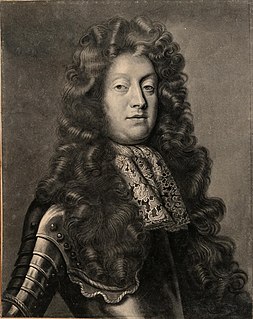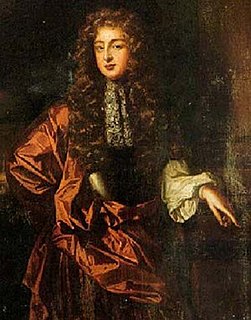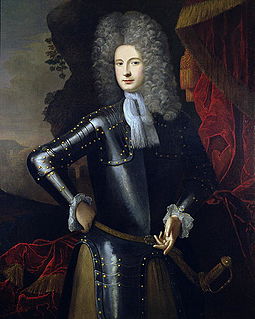Related Research Articles

Patrick Sarsfield, 1st Earl of Lucan, Irish: Pádraig Sáirseál, circa 1655 to 21 August 1693, was an Irish soldier, and leading figure in the Jacobite army during the 1689 to 1691 Williamite War in Ireland.

Richard Talbot, 1st Earl of Tyrconnell PC was an Irish politician, courtier and soldier.

Claud Hamilton, 4th Earl of Abercorn PC (Ire) (1659–1691) was a Scottish and Irish peer who fought for the Jacobites in the Williamite War. He went with King James to Derry in 1689 and tried to negotiate the surrender of the town with Adam Murray. He raised a regiment of horse that he led in the defeats of Newtownbutler in 1689 and Aughrim in 1691. He was killed when the ship that should have brought him to France was intercepted by a Dutch privateer.
Nicholas Purcell, 13th Baron of Loughmoe was the son of James Purcell of Loughmoe and the maternal nephew of James Butler, 1st Duke of Ormonde.
Henry Luttrell was an Irish soldier known for his service in the Jacobite cause. A career soldier, Luttrell served James II in England until his overthrow in 1688. In Ireland he continued to fight for James, reaching the rank of General in the Irish Army.

Theobald Dillon, 7th Viscount Dillon of Costello-Gallin supported King James II, was attainted on 11 May 1691, and fell in the Battle of Aughrim during the Williamite War. His attainder was reversed in favour of the 8th Viscount on 20 June 1694.

Henry Dillon, 8th Viscount Dillon fought for the Jacobites during the Williamite War in Ireland, was attainted but obtained the reversal of the attainder in 1696.
Sir Maurice Eustace, Baronet was an Irish gentleman, the only holder of the Eustace Baronetcy of Castle Martin in County Kildare, which was created for him in the Baronetage of Ireland on 23 December 1685.
Sir James Dillon was an officer in the armies of the Irish Confederate Catholic during the Irish Confederate Wars (1641–53) and a Member of the Parliament of Ireland. He was likely born at Kilfaughny, Athlone and lived in the vicinity.
Arthur Dillon, Count Dillon (1670–1733) was a Jacobite soldier from Ireland who served as Colonel of Dillon's Regiment in the Irish Brigade in French service. He fought in the Nine Years' War and in the War of the Spanish Succession.
Thomas Butler of Garryricken, also known as Thomas Butler of Kilcash and sometimes distinguished by his rank of Colonel, was an Irish landowner. He succeeded to the estates of his grandfather Richard Butler of Kilcash. His brother Christopher was the Catholic Archbishop of Cashel and Emly. Thomas Butler fought for the Jacobites in the Williamite war and was taken prisoner at the Battle of Aughrim. His son John would, de jure, become the 15th Earl of Ormond.
Sir Richard Nagle was an Irish politician and lawyer. He held the positions of Attorney-General for Ireland, Speaker of the Irish House of Commons, Lord Justice of Ireland and Secretary of State and War for Ireland under King James II. He fled to France in 1691, joining James II at Saint Germain, where he resumed his duties as nominal Secretary of State and War. He later served as Commissioner of the Household.
Gordon O'Neill, was an Irish colonel in King James II's army who fought in the Battle of the Boyne and the Battle of Aughrim for the Jacobites. He was a son of Phelim O'Neill.

Sir Robert Talbot, 2nd Baronet (c.1610–1670) was an Irish landowner, soldier and politician of the seventeenth century.
Mark Talbot or Marcus Talbot (c.1649-1702) was an Irish soldier and politician. He was born in Ireland and served in the French army during a time when Irish Catholics were prohibited from serving in the Irish and English armies. His father rose in prominence during the reign of the Catholic James II of Ireland, who purged Protestants from the military and replaced them with Catholics. It was in this time of upheaval that Mark Talbot became a lieutenant colonel in 1689. He served as a commander at Carrickfergus during a Protestant uprising against King James, and on the side of Jacobites in subsequent conflicts. For his efforts, he was promoted to brigadier in 1691, and served as a Member of Parliament for Belfast.
James Talbot was an Irish Jacobite noted for his service in the Irish Army of James II during the War of the Two Kings (1689–91).
Sir Henry Talbot was a seventeenth-century Irish landowner and brother-in-law of Tyrconnell.
William Dorrington was an English army officer. Contemporary sources often spell his surname as "Dorington", or "Dodington".
Dominic Sheldon, often written as Dominick Sheldon, was an English soldier. A leading Jacobite he served in James II's Irish Army during the Williamite War between 1689 and 1691. He was a noted cavalry commander, present at the Battle of the Boyne and Battle of Aughrim. Later after going into exile, he rose to the rank of lieutenant general in the French Army. He was also remained a prominent courtier at the Jacobite court in exile at Saint Germain.
Sir Lucas Dillon of Loughglynn (1579–1656) was in 1628 one of the negotiators of the Graces; he was MP for Roscommon in the two Irish Parliaments of Charles II. At the Irish Rebellion of 1641 he sided with the rebels and joined the Irish Catholic Confederation, where he served on the Supreme Council.